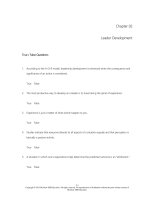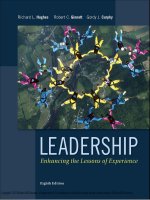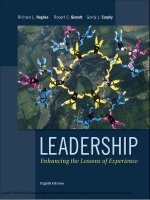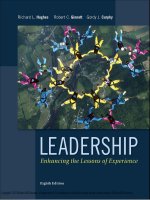Leadership enhancing the lessons of experience 8th by hughes curphy chap 06
Bạn đang xem bản rút gọn của tài liệu. Xem và tải ngay bản đầy đủ của tài liệu tại đây (466.25 KB, 28 trang )
Copyright © 2015 McGraw-Hill Education. All rights reserved. No reproduction or distribution without the prior written consent of McGraw-Hill Education.
Copyright © 2015 McGraw-Hill Education. All rights reserved. No reproduction or distribution without the prior written consent of McGraw-Hill Education.
6-1
Chapter
6
Leadership Attributes
“Watch your thoughts, for they become words.
Watch your words, for they become actions.
Watch your actions, for they become habits.
Watch your habits, for they become character.
Watch your character, for it becomes your
destiny.”
~ Anonymous
6-2
Introduction
• The Great Man Theory attempted to prove that
leaders and followers are fundamentally
different.
• Hundreds of research studies looked at whether
certain personality traits, physical attributes,
intelligence, or personal values differentiated
leaders from followers.
• Researchers made two conclusions:
– Leaders were not qualitatively different than followers.
– Intelligence, initiative, stress tolerance, responsibility,
friendliness, and dominance were moderately related
to leadership success.
6-3
Personality Traits and Leadership
• Personality has two meanings:
– The impression a person makes on others.
– Underlying, unseen structures and processes inside a
person that explain behavior
• Most research about the relationship between
personality and leadership is based on the trait
approach.
– Traits are recurring regularities or trends in a person’s
behavior.
– Trait approach theory maintains that people behave
the way they do, because of the strengths of the traits
they possess.
6-4
Personality Traits and Leadership
(continued)
• Personality traits are useful for explaining why
people act fairly, consistently in different
situations.
– Knowing differences in personality traits can help
predict more accurately how people will tend to act in
different situations.
• Leader behavior reflects an interaction
between personality traits and various
situational factors.
– Weak situations are unfamiliar and ambiguous.
– Strong situations are governed by specific rules,
demands, or organizational policies, which can
minimize the effects that traits have on behavior.
6-5
The Five Factor or
OCEAN Model of Personality
6-6
Implications of the
Five Factor or OCEAN Model
• The Model provides an explanation for leaders’
and followers’ tendencies to act in consistent
ways over time.
– Behavioral manifestations of personality traits are
often exhibited automatically and unconsciously.
– The OCEAN model is useful in many ways.
•
•
•
•
Leaders gain self-insight to improve decision making.
Leadership researchers categorize findings.
Model helps to profile leaders.
Model seems to be universally applicable across cultures.
6-7
Implications of the
Five Factor Model or Ocean
Model
(continued)
• Personality traits:
– Can be reliably categorized into the five major
dimensions of the FFM.
1. Are good measures of leadership potential.
2. Can be used to make predictions about typical
behavior at work.
3. Tend to be difficult to change.
4. Are exhibited automatically and without
conscious thought.
5. Predispose people to act in certain ways, but
behaviors can be modified through experience,
feedback, and reflection.
6-8
OCEAN MODEL PROFILE
6-9
The Differences between
Traits and Types
• An alternative framework to describe the
differences in people’s day-to-day behavioral
patterns is through types, or in terms of a
personality typology.
• Psychological typologies are often expressed
in terms of polar opposites.
– Typologies tend to put people into discrete
psychological categories and emphasize the
similarities among people in the same category and
the differences between people of different types
regardless of actual score.
6-10
Psychological Preferences as a
Personality Typology
• Myers-Briggs Type Indicator (MBTI) measures
psychological preferences, or “mental habits.”
• Each year over 2 million people take the MBTI,
one of most popular psychological tests.
• The MBTI is very popular in college leadership
courses, formal leadership training programs,
and team building interventions
6-11
Psychological Preferences as a
Personality Typology (continued)
• MBTI has four basic preference dimensions.
1. The extraversion-introversion dimension is
concerned with where people get their energy.
2. The sensing-intuition dimension is concerned with
how people look at data.
3. The thinking-feeling is concerned with the
considerations leaders prefer when making
decisions.
4. The judging-perceiving dimension describes the
amount of information needed before a leader is
comfortable making a decision.
6-12
Implications of Preferences
and Types
• Leaders are disproportionately distributed
across a handful of types.
• Despite being useful, the MBTI has limitations.
– Types are not stable over time.
– There are major development changes in distribution
of types with age.
– The utility of typing systems remains uncertain
because the behavior of two people in the same type
may vary as greatly as that of people of different
types.
– Typologies can facilitate the oversimplification of
behavior and the rationalization of misbehavior.
6-13
What is Intelligence?
• Intelligence is a person’s all-around
effectiveness in activities directed by thought.
– Intelligent leaders:
• Are faster learners.
• Make better assumptions, deductions, and
inferences.
• Are better at creating a compelling vision and
strategizing to make their vision a reality.
• Can develop better solutions to problems.
• Can see more of the primary and secondary
implications of their decisions.
• Are quicker on their feet than leaders who are less
intelligent.
• Intelligence is relatively difficult to change
because of heredity but can be modified with
education and experience.
6-14
The Building Blocks Of Skills
6-15
The Triarchic Theory of Intelligence
• The triarchic theory of intelligence focuses on
what a leader does when solving complex
mental problems.
• According to the theory, there are three basic
types of intelligence.
1. Analytic intelligence: general problem-solving ability
2. Practical intelligence: street smarts
3. Creative intelligence: ability to produce novel and
useful work
• Assessing creativity involves using
–
–
Divergent thinking tests –many possible answers
Convergent thinking tests –one single best answer
6-16
Implications of the Triarchic Theory
of Intelligence
• Leadership effectiveness or emergence is
positively correlated with analytic intelligence.
• Sometimes, personality is much more predictive
of leadership emergence and effectiveness than
analytic intelligence.
• In certain cases, analytic intelligence may have
a curvilinear relationship with leadership
effectiveness.
• Leaders’ primary role is to build an environment
where others can be creative.
6-17
Implications of the Triarchic Theory
of Intelligence (continued)
• To improve the group and organizational
factors affecting creativity, leaders should
be mindful that:
– Various sorts of incentives or rewards can have
various effects on creativity.
– Synthetic abilities can be hindered if ideas will be
evaluated.
– In order to develop new products and services,
the level of turnover should be low, and goals
should be clear.
– Creeping elegance should be avoided.
6-18
Creativity Killers: How to Squelch
the Creativity of Direct Reports
6-19
Intelligence and Stress:
Cognitive Resources Theory
• Cognitive Resources Theory is a conceptual
scheme for explaining how leader behavior
changes under stress levels to impact group
performance.
• CRT consists of several key concepts:
– Intelligence, experience, stress, and group
performance.
• Theory predictions include:
– Greater experience but lower intelligence may
account for higher-performing groups in high stress
conditions.
– High levels of experience may account for usage of
old solutions when creative solutions are more apt.
6-20
Intelligence and Stress:
Cognitive Resources Theory (continued)
• Problematic issues concerning CRT:
– Apparent dichotomy between intelligence and
experience
– Leader’s ability to tolerate stress
– Correlation between dark-side traits and stress
• Leadership implications of CRT:
– The best leaders are often smart and experienced.
– Leaders may be unaware of the degree to which they
are causing stress in their followers.
– The level of stress inherent in the position needs to be
understood before selection of leaders.
6-21
What is Emotional Intelligence?
• There are 4 major definitions of emotional
intelligence that can be broken down into two
models:
1. The Ability Model focuses on how emotions affect
the way leaders think, decide, plan, and act.
2. The Mixed Model provides a broader and more
comprehensive definition than the ability model
because it includes more leadership qualities.
• The Mixed Model is more popular among HR
professionals than the Ability Model, but no more
predictive of job performance than OCEAN
assessments.
6-22
Ability and Mixed Models of
Emotional Intelligence
6-23
Comparison between the OCEAN Model
and Goleman’s Model of EQ
6-24
Can Emotional Intelligence Be
Measured and Developed?
• The Emotional Competence Inventory (ECI )
was developed by Daniel Goleman in 1998.
• ECI consists of 10 questionnaires to be
completed by the individual and 9 others.
• Instruments often provide leaders with
conflicting results.
• Most researchers agree that Emotional Quotient
Inventory (EQ) can be developed.
6-25









